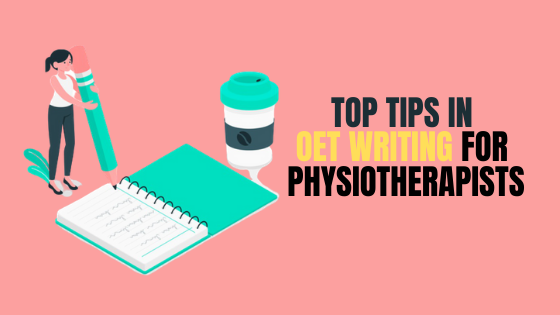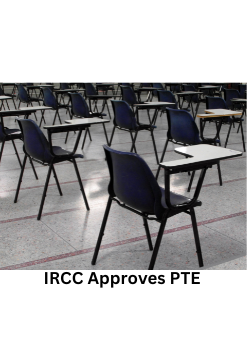Are you aiming to work or study abroad in the field of Physiotherapy?
Then you’ll first need to clear the Occupational English Test or OET – a test that qualifies you as proficient in English for professional use.
Here at Hurray, we offer the best Online OET Training guaranteed to help you gain success in the exam! Individual-oriented and flexible, and bolstered by our 8 years of experience, you will find our OET online course to be well-suited to your needs – with the benefit of accessing it from wherever you are!
In this blog post, we will break down the OET writing test for you – along with a few tips and strategies suggested by our experienced and expert trainers, spearheading our OET online training programme.
*Update for Covid-19: For all of you staying home, we are here to assist you with your OET preparation during lockdown. We offer OET Online Training – combining all the benefits of our classroom-based programme, with the added advantage of being accessible from the safety of your home!
Furthermore, all of our blog content can be used as frameworks guiding your practice and study efforts – so you can make the most of this time!
About the Writing Test
The test consists of a single task i.e. letter writing.
The test is designed to test your ability to communicate via writing, drawing on actual professional circumstances.
The test is profession-specific – which means that you will be given a task specific to the occupation selected during registration i.e. for you, physiotherapy. The test is so designed based on the understanding that each profession has specific communication requirements.
The most common letter type is the referral letter, followed by the discharge/transfer letter; others include letter informing a patient, carer or group, or a response letter to a complaint.
In addition to the letter prompt, you will be provided with supporting details in the form of case notes, and other relevant documentation.
Scoring:
You will be scored on the basis of the following parameters:
-
Purpose – is the purpose of the letter is immediately apparent to the reader and sufficiently expanded in the course of the letter?
-
Content – is all the necessary information included and accurate?
-
Conciseness and Clarity – is the letter is an effective summary for the reader, excluding unnecessary information?
-
Genre and Style - is the register (type of language), tone and use of abbreviations appropriate for the target reader?
-
Organisation & Layout – is the letter organised and well laid out?
-
Language – involving grammar, vocabulary, spelling and punctuation
Tips for Preparation
The key to good writing – whether in professional or other circumstances – is preparation! Read on for our tips on how to prepare yourself to ace OET writing.
-
Build Vocabulary and Grammar skills
Vocabulary skills involve knowing a large number of words, what they mean, spellings and appropriate use. Good grammar includes the correct use of functional aspects of language, such as verbs and tenses, punctuation, articles, pronouns and prepositions.
As a medical professional, your vocabulary must be strong on profession-specific and technical words – but for the purpose of professional communication, you must also have an excellent colloquial vocabulary and grammar skills…all to ensure that the essential message you have to communicate is understood perfectly by your reader!
The best way to build these skills is to read good material and watch/listen to informative programmes, where good English is bound to be used (you can trust magazines like Time or National Geographic and news channels like the BBC).
-
Build a Repertoire…
…of words and phrases that you can incorporate in your writing. For instance,
-
In the introduction, based on the purpose of the letter:
“I am writing to refer…”
“This letter is in regards to the discharge/transfer…”
-
To ensure coherence and cohesion:
“In addition to” or “furthermore”, to indicate connection
“Thus”, “therefore”, “accordingly”, to indicate causality
“Differentiate” or “distinguish between”, to indicate difference
-
In the conclusion, involving a call to action:
“Based on the above, I recommend…”
“In light of this, I request…”
Tips for Task Performance
-
Managing Time and Word Limit
You will be given a time limit of 45 minutes to complete the task, and are expected to adhere to a word-limit of 180-200 words.
It is suggested that the first 5 minutes be used to prepare for the task, with the remaining 40 minutes reserved for writing.
We suggest the following tips to utilise the prep time well:
-
Read the prompt carefully to identify the purpose of the letter
-
Skim-read the case notes
-
Identify and make quick note of the information which is relevant, keeping in mind the purpose of the letter
-
Number your selected points, to form a particular order, which you will use to structure your letter
Remember that not all the information will be of use to a particular reader – choose your points carefully and with discretion. You will comfortably stay within the word and time limits, if you successfully select only the most relevant information.
-
Structure and Format
With regard to structure, we suggest the following:
-
Begin with a clear introduction, wherein the purpose of the letter is immediately apparent
-
Divide your letter into short, clear paragraphs – depending on the nature and amount of content
-
There must be a clear concluding paragraph, typically containing a call to action
OET does not specify any particular letter-format or template. The only stipulation is that the format utilised must be clear and well-structured, in accordance with the scoring parameters you read above.
-
Language
-
While the information in the case-notes will be given in point-form, you are expected to write in full sentences
-
Any abbreviations or profession-specific vocabulary must be used, keeping in mind the target reader’s expected ability to understand
-
Use the repertoire of words you build to maintain a good flow
Example
We’re referring to the official OET sample tests to help you get an idea of what your OET writing test will involve.
Prompt: Using the information in the notes, write a letter back to the referring GP detailing your findings and suggested treatment plan. Address your letter to Dr William Stacey, Greywalls Clinic, 23 Station Road, Greywalls and date it 1st May 2018.
To study the case notes, follow this link. (https://prod-wp-content.occupationalenglishtest.org/resources/uploads/2019/04/23135756/Writing-Physiotherapy-Sample-Test-1.pdf)
The following example is indicative only – refer to it to get an idea of how to approach the letter and how to structure it coherently. Using this as a guide, and the above tips – try to craft your own!
|
To, Dr William Stacey, Greywalls Clinic, 23 Station Road, Greywalls.
|
Date: 01/05/2018 |
|
Subject: regarding Mr Max Wolff, aged 35
Dear Dr Stacey,
Based upon your referral, Mr Wolff attended my clinic yesterday for a review and treatment plan. I am writing to update you of the details.
Mr Wolff reports upper back pain between his shoulders, that is aggravated by prolonged performance i.e. over two hours, as a part of his musical profession. The pain is usually eased by rest. In addition, he reports dull pain in his lumbar spine. The symptoms have been developing for 6-10 months. He has recently been using low-strength analgesics to aid sleep.
I have diagnosed a mild thoracic kyphosis with protraction of both scapulae and forward head posture. Mild scoliosis is evident on the patient’s right side with lumbar tightness (stiff segment T3- T8) and 3/4 range spinal rotation.
I have accordingly formulated a treatment plan, for which Mr Wolff will attend twice-weekly sessions for three weeks until the start of the concert tour. Posture training and spinal mobilisation has been initiated, with home exercises involving rotation and stretching. I will introduce strength exercises and self-massage at our next session. Mr Wolff will be able to participate in the tour but will need to continue his treatment.
Please contact me for further details or clarifications.
Thank you.
Yours sincerely, (Name + designation, if given) |
|
Based on this sample, you may observe the following:
-
Only the most immediate and relevant information has been included – regarding the patient’s recent history and symptoms, the outcome of the examination and the subsequent treatment plan.
-
Information regarding the patient’s family history as well as the patient history not relevant to his current problem have been omitted.
-
Specific details from the patient’s discussion with the physiotherapist (you), the examination, as well as the treatment plan have also been omitted.
The inclusions and omissions are carefully strategized to ensure that the recipient of the letter learns only what is required, for him to understand the patient’s situation. Keeping the letter concise and relevant prevents time wastage for both writer and reader, as well as promotes easy understanding and further action.
These tips and strategies are only the tip of the iceberg – with the Hurray Online OET Training you will learn much more, and be prepared accordingly, to ace the test!
To learn more, reach out to us via email: info@hurrayedutech.com or call us on: 8971357938.











Post Comments